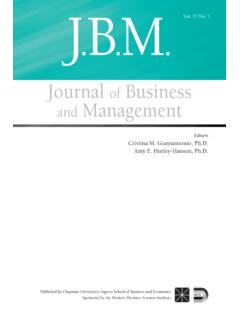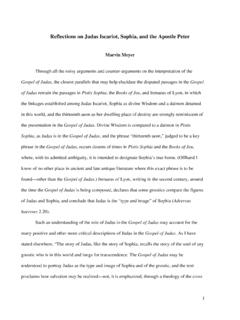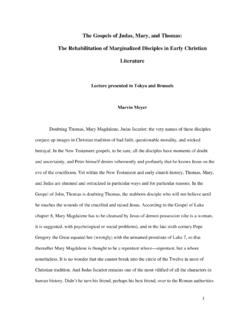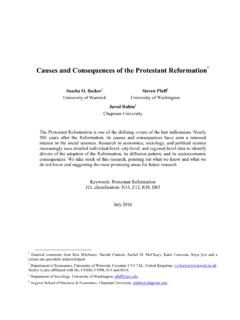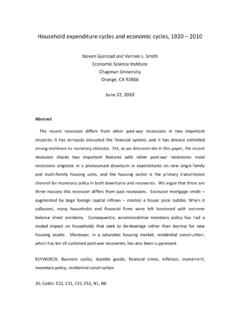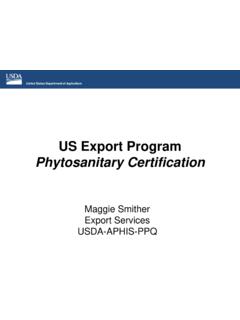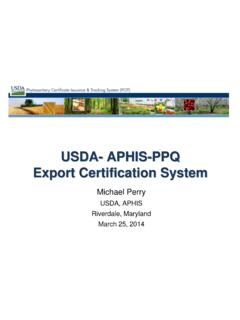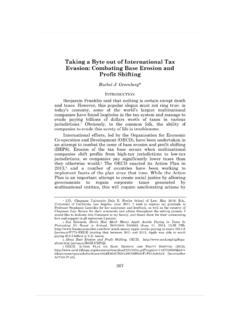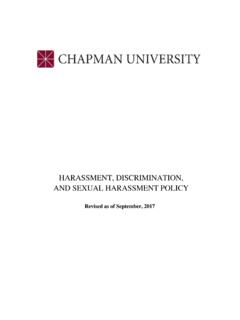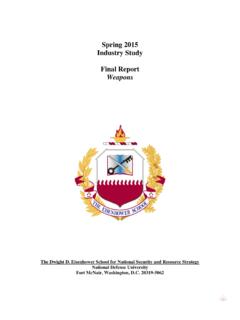Transcription of Suing the Firearms Industry: A Case for Federal Reform
1 HALBROOK FINAL MAY 28 5/28/2004 4:19 PM 11 Suing the Firearms industry : a case for Federal Reform Stephen P. Halbrook* I. INTRODUCTION A wave of lawsuits against the Firearms industry for criminal acts of third parties crested and substantially evaporated during the 1980s. Primarily brought by individual plaintiffs, these suits alleged a variety of theories of negligence (including negligent design and marketing), strict liability for defective (actually nondefective) products, and ultra-hazardous activity. Since the Firearms at issue worked properly and were made and distributed lawfully, these cases were by and large dismissed as failing to allege cognizable While such individual actions continue to be brought and are usually dismissed,2 in the late 1990s municipalities began to * Attorney at Law, Fairfax, Virginia; , Georgetown University Law Center; Philosophy, Florida State University.
2 Argued Printz v. united states , 521 898 (1997) and other Firearms cases in the Supreme Court. Author of Firearms LAW DESKBOOK (West 2003) and three books on the right to bear arms. See Copyright 2004 by Stephen P. Halbrook. All rights reserved. 1 , Delahanty v. Hinckley, 564 758, 759-60 ( Cir. 1989) (holding that there is no duty where crime victims had no special relation with manufacturers); Bennet v. Cincinnati Checker Cab Co., 353 F. Supp. 1206 ( Ky. 1973) (holding that there is no duty where no special relationship existed between gun manufacturer and person injured by misuse of gun); Riordan v. Int l Armament Corp., 477 1293, 1296 (Ill. App. Ct. 1985) (finding that a manufacturer of nondefective handgun had no duty to control distribution of product to general public). But see Kelley v. Indus., Inc., 497 1143, 1159 (Md.)
3 1985) (finding liability for Saturday Night Special ), superseded by MD. CODE ANN., PUB. SAFETY 5-402(b) (2003). 2 , Bloxham v. Glock Inc., 53 196, 201 (Ariz. Ct. App. 2002) (noting that other courts faced with similar issues have almost uniformly refused to impose any duty on businesses related to the legal use and distribution of Firearms owed to those harmed by the misuse of those Firearms . ); First Commercial Trust Co. v. Lorcin Eng g, Inc., 900 202, 205 (Ark. 1995) (finding no special relation between manufacturer and handgun purchaser); Valentine v. On Target, Inc., 727 947, 953 (Md. 1999) (finding that the inherent danger of guns creates no duty of dealers to persons who may be harmed); Resteiner v. Sturm, Ruger & Co., 566 53, 54 (Mich. Ct. App. 1997) (finding appeal to be vexatious and awarding attorney s fees; suit involved stolen weapon used in murder).
4 See also TIMOTHY A. BUMANN, THE COMPENDIUM OF REPORTED united states Firearms PRODUCTS LIABILITY CASES: A SYNOPSIS OF CIVIL LITIGATION AGAINST MANUFACTURERS AND SELLERS (1995). HALBROOK FINAL MAY 28 5/28/2004 4:19 PM 2004] Suing the Firearms industry 12 bring similar lawsuits against the Firearms industry . The same theories continued to be alleged but a new one was added: public nuisance. Under this theory, it is alleged that the Firearms industry intentionally supplies the criminal market by manufacturing more Firearms than lawful demand would support. During 1998-2003, some thirty-three municipalities and counties filed suits against the Firearms The following briefly analyzes some representative cases of the current litigation against the Firearms industry , including discussion of the public nuisance theory and the effect on the constitutionally-guaranteed right to keep and bear It then provides a detailed analysis of the Ninth Circuit s Ileto v.
5 Glock decision, which pushes the envelope by basing its claim of wrongdoing on the marketing of guns to police departments in states with less strict firearm laws. Lastly, this Article evaluates the provisions of the Protection of Lawful Commerce in Arms Act, which is pending in the united states Congress and would preempt these types of suits against the Firearms industry . II. IS THE RIGHT TO BEAR ARMS A PUBLIC NUISANCE? Typical allegations made in the current wave of anti- industry lawsuits are summarized in Camden County Board of Chosen Freeholders v. Beretta, Corp.,6 as follows: [T]he manufacturers release into the market substantially more handguns than they expect to sell to law-abiding purchasers; the manufacturers continue to use certain distribution channels, despite knowing (often from specific crime-gun trace reports produced by the Federal Bureau of Alcohol, Tobacco, and Firearms ) that those channels regularly yield criminal end-users.
6 The County makes no allegation that any manufacturer violated any Federal or state statute or regulation governing the manufacture and distribution of Firearms , and no direct link is alleged between any manufacturer and any specific criminal 3 Litigation Against the Gun industry , Violence Policy Ctr., (last visited Mar. 8, 2004); Taxpayer Funded Reckless Lawsuits Against The Firearms industry , Nat l Rifle Assoc., (posted Aug. 19, 2003). 4 The Second Amendment of the Constitution provides, A well regulated Militia, being necessary to the security of a free State, the right of the people to keep and bear Arms, shall not be infringed. For a current listing of State arms guarantees, see Eugene Volokh, State Constitutional Right to Keep and Bear Arms Provisions, ~volokh/ (last visited Apr. 15, 2004). 5 349 1191 (9th Cir.)
7 2003). 6 273 536 (3d Cir. 2001). 7 Id. at 539. HALBROOK FINAL MAY 28 5/28/2004 4:19 PM 13 Chapman Law Review [Vol. 7:11 Actually, manufacturers become aware of traces when the Bureau of Alcohol, Tobacco, and Firearms ( BATF ) requests information, but a mere trace request does not imply that any of the links in a distribution channel committed any wrongdoing or even that a crime was committed with the firearm At any rate, the Third Circuit held that no New Jersey court has ever allowed a public nuisance claim to proceed against manufacturers for lawful products that are lawfully placed in the stream of commerce. 9 It added, To extend public nuisance law to embrace the manufacture of handguns would be unprecedented under New Jersey state law and unprecedented nationwide for an appellate court. 10 In Penelas v. Arms Technology, Inc.]
8 ,11 Florida s Third District Court of Appeal affirmed the dismissal of all theories of liability in Miami-Dade County s suit against the Firearms Noting that virtually all appellate decisions from other states precluded liability, the court relied on Florida precedent holding that liability does not exist where the firearm was not defective, its manufacture and distribution were consistent with state and Federal law, and no duty was breached by the Penelas observed: The County s request that the trial court use its injunctive powers to mandate the redesign of Firearms and declare that the appellees business methods create a public nuisance, is an attempt to regulate Firearms and ammunition through the medium of the judiciary. Clearly this round-about attempt is being made because of the County s frustration at its inability to directly regulate Firearms , an exercise proscribed by section , Florida Statutes (1999) which expressly preempts to 8 Traces frequently implicate nothing about the first retail purchaser, much less the licensee.
9 According to the Solicitor General: If the tracing process is successful, it will identify the first retail purchaser of the traced firearm ; yet that person may have long since relinquished ownership of the weapon and may have no connection to the underlying crime. Brief for the Petitioner at 27, BATF v. City of Chicago, 537 1229 (2003) (No. 02-322) (internal citations omitted). Indeed, because the agency requesting the trace does not inform ATF of whether possessors and their associates are ever indicted or convicted of any offense, ATF has no way of knowing whether the law enforcement agency requesting the trace believes the possessor or associate to have had any role in the crime. Id. at 10 (internal citations and quotations omitted). Finally, ATF has informed this Office that approximately 30% of all trace requests do not tie the weapon to any individual possessor.
10 Id. at 41. 9 Camden, 273 at 540. 10 Id. at 540-41. See also City of Philadelphia v. Beretta Corp., 277 415, 419 (3d Cir. 2002) (rejecting liability of firearm manufacturers under negligence, negligent entrustment, and public nuisance theories for costs incurred by city associated with the criminal use of handguns). 11 778 So. 2d 1042 (Fla. Dist. Ct. App. 2001). 12 Id. at 1044. 13 Id. (citing Trespalacios v. Valor Corp. of Fla., 486 So. 2d 649, 650 (Fla. Dist. Ct. App. 1986)) (finding no liability for shotgun). HALBROOK FINAL MAY 28 5/28/2004 4:19 PM 2004] Suing the Firearms industry 14 the state legislature the entire field of firearm and ammunition regulation. The County s frustration cannot be alleviated through litigation as the judiciary is not empowered to enact regulatory measures in the guise of injunctive The court cited references for additional discussions of the right to bear arms, 15 but did not explicitly quote Florida s arms Of course, where clear statutory grounds exist for a decision, courts prefer not to raise constitutional issues.
